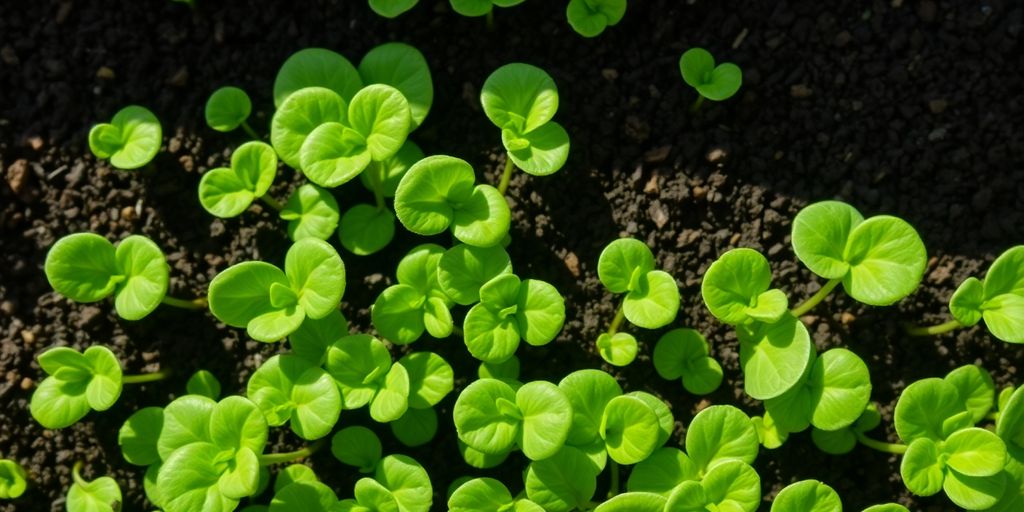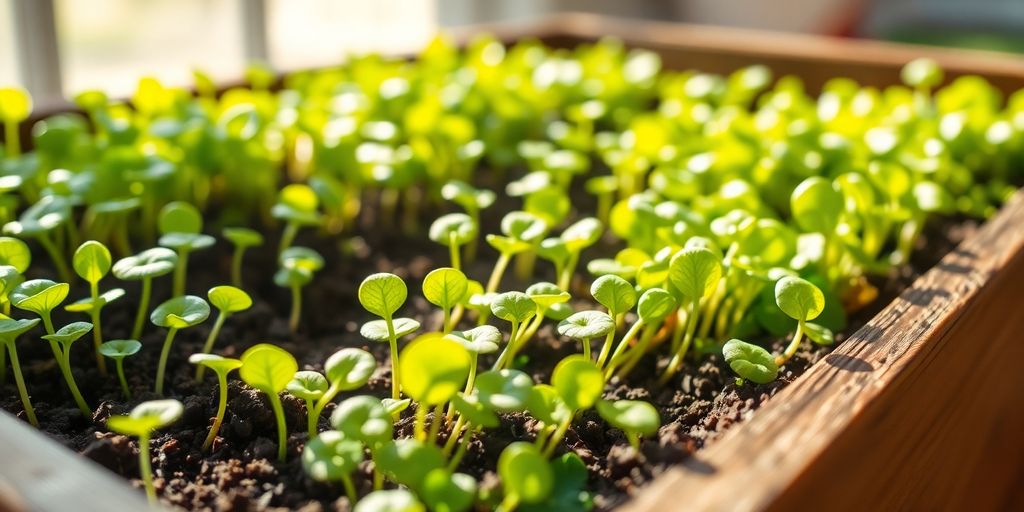So, you’re thinking about growing microgreens and actually making some money from it? That’s awesome. But figuring out how much to charge can feel like a puzzle, right? You’ve got costs for seeds, soil, lights, and your time. Then there’s the whole yield thing – how much do you actually get from a tray? It’s a lot to juggle. That’s why having a good microgreens profitability calculator, or at least a solid way to figure out your numbers, is super important. We’ve been there, and we learned a ton about what goes into pricing these little greens.
Key Takeaways
- Know your numbers inside and out, from seeds to electricity. This is the bedrock of your pricing.
- Figure out how much you can actually grow per tray and how long it takes. This helps you predict output.
- Don’t forget to pay yourself! Labor costs are real, even if it’s just you doing the work.
- Look at what others are charging, but don’t just copy them. Understand why they charge what they do.
- Pricing isn’t set in stone. Keep an eye on your costs and sales, and be ready to tweak your prices.
Calculating Your Microgreens Production Costs
When we first started growing microgreens, we were so focused on how pretty they looked. But then we realized that if we wanted to actually make money, we needed to get real about the costs involved. It’s not just about the seeds and soil, you know? There’s a lot more that goes into it. Figuring out these numbers is the first real step to making sure you’re not just spinning your wheels.
Direct Input Costs
These are the things you can physically touch and use up. Think seeds, the growing medium (like coco coir or peat moss), the trays themselves, and any packaging you use. We noticed pretty quickly that seed costs can really change depending on what you’re growing. Some, like arugula, cost more than others, say, radishes. We also decided to go with compostable packaging, which was a bit pricier upfront, but it fit with what we wanted our business to be about. It’s worth looking at different suppliers to see where you can get the best deals without sacrificing quality.
Labor Costs
This is a big one, and it’s easy to forget if you’re the only one doing the work. Your time has value! We had to sit down and figure out how much time seeding, watering, harvesting, and packing each batch took. Even if it’s just you, you need to pay yourself. We tracked our hours for each task, and it really added up. Don’t underestimate how much time these steps take, especially when you’re starting out.
Utility and Facility Overhead Costs
This category covers all those recurring bills. Water, electricity for lights and fans, maybe rent if you’re not using a home space, and even things like cleaning supplies. We learned to keep a close eye on our electricity usage, especially with the grow lights. We even got a little device to measure how much power the outlets we used were drawing. It helped us avoid any nasty surprises on the utility bills. If you’re using a portion of your home, figuring out a fair percentage for that space is important too. This is where a tool like our profit calculator can really help break down these less obvious costs.
Understanding these costs isn’t a one-time thing. It’s something you have to keep doing. We made a lot of notes, and honestly, we learned a ton from our mistakes. It’s all part of building a business that actually works.
Understanding Microgreen Yields and Growth Cycles
Understanding how much you can grow and how long it takes is pretty important if you want to make money with microgreens. It’s not just about planting seeds and hoping for the best; you really need to know your numbers. When my partner and I started out, we learned this the hard way. We had to figure out the rhythm of our plants to price things right.
Researching Production Yields
First off, you need to find out how much you can realistically expect to harvest from a standard tray for each type of microgreen. Some, like arugula, might give you a different amount than, say, radishes. We looked at a bunch of different studies and talked to other growers to get a general idea. If you’re just starting, looking up information on seeding density and expected yields for different varieties is a good first step. You can find a lot of helpful info online, like from seed suppliers who often do their own trials.
Factoring Growth Timing
Every single microgreen has its own timeline from when you plant the seed to when it’s ready to harvest. We had to learn to recognize the perfect moment for each one. Harvesting too early means you get less product, and harvesting too late can mess with the quality. It’s a bit of an art, but mostly it’s about paying attention.
Determining Output Capacity
Once you know your yields and growth times, you can figure out how much you can actually produce. This means looking at how many trays you can handle at once, considering the different growth cycles. It helps you plan your planting schedule so you have a steady supply, rather than a huge glut one week and nothing the next.
Measuring Yields and Cycles
Don’t just trust what you read online. You really need to measure your own results. Keep track of how much you harvest from each tray and how long each crop takes to grow in your specific setup. This hands-on data is way more accurate and helps you adjust your plans as you go. It’s how you really get a handle on your production.
Knowing your yields and growth cycles isn’t just about numbers; it’s about understanding the plants you’re growing. It’s about paying attention to their needs and their natural timing. This knowledge helps you run your business smoothly and price your products fairly, reflecting the effort and care you put in. It’s a dance worth learning, and you can definitely master it with practice.
Estimating Per-Unit Production Costs

Once you’ve got a handle on your production costs and understand your yields, the next logical step is figuring out the cost for each unit you produce. This isn’t just about knowing your total expenses; it’s about breaking it down so you can price things smartly. Knowing your per-unit cost is the bedrock of a profitable business. It helps you see exactly where your money is going for every tray, every ounce, or whatever unit you sell.
Maximizing Yields Through Planning
To get your per-unit costs as low as possible, you really need to think about maximizing your yields. This means planning your grow cycles carefully. For instance, we learned that certain microgreens, like sunflower, tend to have higher yields per tray compared to others. By prioritizing those with better yields or by optimizing growing conditions for those that are a bit trickier, you can spread your fixed costs over more product. It’s about making sure every bit of space and every hour of labor is working as hard as it can for you. We found that adjusting our seeding density based on research, like that from Johnny’s Selected Seeds, made a big difference in how much we got from each tray [1].
Adapting to Seasonal Fluctuations
Don’t forget that things change throughout the year. Your utility costs might go up in the summer if you need more cooling, or your lighting costs could shift depending on natural light availability. You also need to consider if certain microgreens grow better during specific seasons. Being flexible and adjusting your production plan or even your pricing slightly to account for these seasonal changes can prevent surprises. Maybe you grow more of a particular crop in the winter when demand is high and energy costs are lower, and then switch to something else in the summer. It’s all about staying agile.
Calculating your cost per unit isn’t a one-and-done task. It’s an ongoing process that requires you to keep good records and be willing to adjust as you learn more about your specific growing environment and market. Stephen and I found that the more diligent we were with tracking, the better our pricing became, which directly impacted our bottom line.
Setting Microgreens Profit Margin Hurdles
Establishing Target Profit Margins
First things first, you need to figure out what kind of profit you’re aiming for. This isn’t just a random guess; it’s about setting specific goals for how much you want to make after all your costs are covered. Think about different types of customers or sales channels – maybe restaurants expect a different margin than a farmers’ market customer. We found that setting clear targets, like aiming for a 30% profit on wholesale orders and maybe 50% for direct-to-consumer sales, really helped focus our efforts.
Validating Costs
Before you can even think about profit, you absolutely have to know your numbers. This means going back through all those direct input costs, labor, and overhead we talked about earlier. You need to be sure your selling price is actually covering everything, and then some. It’s easy to forget small things, like packaging tape or the electricity for that one extra light, but they add up. We made a point to double-check our cost per tray calculations regularly. It’s a bit tedious, but it’s the only way to know if you’re truly making money. If your costs are higher than you thought, you might need to adjust your growing methods or find cheaper suppliers. Sometimes, just understanding your costs better can lead to savings. For instance, realizing how much water we used per tray prompted us to look into more efficient watering systems.
Comparing Against Industry Research
It’s smart to see what other microgreen growers are doing. Look up what typical profit margins are in the industry. Are you in line with others, or are you way off? This research can give you a reality check and highlight areas where you might be overspending or underselling. We checked out some industry reports and found that small vegetable businesses often see gross profit margins between 25-50%. Knowing this helped us benchmark our own goals and make sure we weren’t being unrealistic. It’s not about copying others, but about understanding the market landscape so you can position yourself effectively.
Setting Higher Margins for Specialty Offerings
Some microgreens are just trickier to grow or have a more niche market. Think about things like edible flowers or very delicate varieties that require extra care. It makes sense to charge a bit more for these. We decided to put a higher profit margin hurdle on our specialty items because they often have higher seed costs, longer grow times, or a greater risk of crop failure. This extra buffer helps cover those increased risks and the extra attention they need. It’s a way to reward yourself for taking on those more challenging, but potentially more rewarding, crops.
Pricing isn’t just about covering costs; it’s about valuing your time, your skill, and the quality product you’re putting out there. Don’t be afraid to price yourself appropriately.
Key Takeaways for a Profitable Microgreens Pricing Strategy
So, you’ve crunched the numbers on your costs and figured out your yields. Now comes the part where you actually make money. Setting your prices isn’t just about picking a number out of thin air; it’s a strategic move. You need to make sure your prices reflect the quality you’re putting out there and, you know, actually cover everything you spent. It’s about finding that sweet spot where customers feel they’re getting a good deal and you’re making a decent profit.
Layered Factors
Pricing isn’t a one-size-fits-all deal. You’ve got to think about a bunch of things. Who are you selling to? Are they home cooks looking for a few ounces, or are they fancy restaurants needing consistent, high-volume orders? Each group has different expectations and budgets. Also, consider the type of microgreen. Some are just naturally more expensive to grow or have a higher demand, like arugula or sunflower shoots. You’ll want to price those accordingly. Don’t forget about packaging and delivery costs, too – those add up!
Research-Based Approach
Don’t guess what others are charging. Take some time to look around. See what similar microgreens are going for at local farmers’ markets, in grocery stores, or even online. This gives you a baseline. You don’t want to be the cheapest, but you also don’t want to price yourself out of the market. Understanding the competition helps you position your own product effectively. It’s about finding your place in the market, not just blindly following.
Continuous Testing and Adjusting
Pricing isn’t a set-it-and-forget-it thing. The market changes, your costs might change, and customer demand can shift. Keep an eye on your sales. If something isn’t moving, maybe the price is too high, or perhaps you need to promote it better. If everything is flying off the shelves and you’re barely making a profit, it might be time to nudge those prices up a bit. Regularly reviewing your pricing strategy is key to long-term success. It’s a good idea to buy microgreen seeds in bulk to help manage your costs.
It’s important to remember that your pricing should also communicate the value you provide. If you’re using organic practices, offering unique varieties, or providing exceptional customer service, these are all points that can justify a premium price. Don’t be afraid to tell your customers the story behind your greens; it helps them understand why they’re worth it.
Essential Tools for Tracking Profitability

Keeping a close eye on your finances is super important if you want your microgreens business to actually make money. It’s not just about growing nice greens; it’s about knowing exactly what it costs you to produce them and what you need to charge to turn a profit.
Record Keeping
This is where a lot of new growers get tripped up. You really need to keep track of every single expense, no matter how small. We used a simple spreadsheet at first, but honestly, if you’re serious, something like QuickBooks is a good idea. The University of Maryland’s Agricultural extension even has a helpful add-in for it. Good record-keeping helps you figure out where your money is actually going. It’s the first step to understanding your true costs and finding ways to save money without cutting corners on quality. You can find some great agriculture apps to help manage daily operations too, which can feed directly into your financial tracking [d44c].
Cost Per Unit Sale
Once you’ve got your records, you need to break down your costs per unit. This means figuring out how much it costs to produce one tray, or even one ounce, of microgreens. For example, knowing that a 1.75 oz package might sell for $3.49 to $4.99 in your local market helps you see how your own costs stack up. This kind of detail lets you position your product competitively and make sure you’re not leaving money on the table.
Tracking Costs Across the Growing Cycle
Microgreens have different growth times, and your costs change throughout that cycle. You’ve got seeds, soil, water, electricity for lights, your time, packaging – it all adds up differently from planting to harvest. Developing a system to track these costs from start to finish is key. It helps you see where the biggest expenses are and if there are ways to be more efficient.
Understanding your costs isn’t a one-time thing. It’s an ongoing process. You have to be diligent, pay attention to the details, and be willing to learn from what works and what doesn’t. It’s how you build a solid foundation for setting prices that actually make sense for your business.
Determining Your Microgreens Selling Price
So, you’ve crunched the numbers on your costs and figured out your yields. Now comes the part where you actually decide what to charge for your beautiful microgreens. This isn’t just about picking a number out of thin air; it’s a strategic move that impacts your whole business. Getting your pricing right means customers see the value and you actually make money.
How Microgreens Are Typically Priced
Most growers don’t sell microgreens by weight like you might see at a farmer’s market for other produce. Instead, they usually price them by unit, like a clamshell container or a sealed bag. For retail, you’ll often see prices ranging from about $2.00 and up per ounce, but this can really change depending on the type of microgreen, how fresh it is, and if it’s organic. Think about what other local growers are charging, too. You want to be competitive, but don’t sell yourself short. It’s a balance.
Calculating Gross Margin
Once you know your selling price and your cost to produce each unit (which we talked about earlier), you can figure out your gross margin. This is basically your profit before you even think about other business expenses like marketing or rent. The formula is pretty straightforward: Selling Price per Unit – Cost Per Unit = Gross Margin per Unit. A healthy gross margin is what keeps your business going.
Factors Influencing Seed Density and Yield
Remember how different microgreens have different growth habits? That directly affects how much you can harvest from a single tray. Some varieties, like sunflower or pea shoots, are pretty generous with their yield, often giving you a pound or more per tray. Others, like cilantro or basil, might give you closer to 8-12 ounces. This difference in yield is a big reason why prices can vary between different types of microgreens. If you’re planting denser, you might get more weight, but you also need to consider if that density impacts the quality or makes harvesting harder. It’s all connected.
You need to make sure your selling price covers not just the cost of seeds, soil, and water, but also your time and any overhead. If you’re not making a profit on each sale, you’re just working for free, and that’s no way to run a business. Always aim to price your products so that you have a good buffer for unexpected costs and to reinvest in your farm. This is how you build a sustainable microgreens operation.
For a deeper dive into selecting the best varieties for your market, check out this guide on microgreens cultivation.
Here’s a quick look at how yield can affect potential earnings per tray:
| Microgreen Variety | Estimated Yield per 1020 Tray | Potential Earnings per Tray (at $30/lb) |
|---|---|---|
| Sunflower Shoots | 12-16 oz | $22.50 – $30.00 |
| Pea Shoots | 12-16 oz | $22.50 – $30.00 |
| Radish | 8-12 oz | $15.00 – $22.50 |
| Broccoli | 8-10 oz | $15.00 – $18.75 |
| Arugula | 6-8 oz | $11.25 – $15.00 |
Putting It All Together for Profit
So, we’ve walked through all the numbers, from the cost of seeds to how much time you spend. It’s a lot to keep track of, for sure. But really, knowing your costs is the first step to making sure you’re actually making money with your microgreens. It’s not just about growing pretty plants; it’s about building a business that lasts. Keep an eye on your expenses, adjust your prices when you need to, and remember that this whole thing is a process. You’ll learn as you go, and that’s how you’ll find what works best for you and your farm. You can totally do this.
Frequently Asked Questions
What are the main costs I need to consider when growing microgreens?
To figure out your costs, you need to look at everything you spend money on. This includes the seeds, the soil, the trays you grow them in, and even the packaging. Don’t forget about things like electricity for your lights, water, and maybe rent if you have a special place for growing. Also, remember to count the time you spend doing the work, because your time is valuable!
Why is understanding microgreen yields and growth cycles important for pricing?
Yield is how much you get from each tray of microgreens, and growth cycles are how long it takes them to grow from seed to harvest. Knowing these helps you figure out how much you can grow and sell. Different types of microgreens grow at different speeds and give you different amounts, so it’s good to track this.
How do I calculate the cost per unit for my microgreens?
You can figure out the cost for each tray or even each ounce by adding up all your expenses and dividing by how much you produce. This helps you know the lowest price you can sell for and still make money. For example, if a tray costs $3 to make and you get 10 ounces from it, your cost per ounce is $0.30.
What is a profit margin, and how do I set one for my microgreens?
A profit margin is the money you make after covering all your costs. You should set goals for how much profit you want to make on each sale. Compare your costs and desired profit to what others in the business are doing to make sure your prices are competitive but still make you money.
How do I decide how much to charge for my microgreens?
You can figure out your selling price by looking at how much it costs to grow them, how much you can harvest, and what similar microgreens sell for in your area. It’s also smart to add a bit extra for profit. Think about what makes your microgreens special, like unique flavors or how you grow them, which might let you charge a little more.
What are the best ways to keep track of my microgreens business finances?
Keeping good records is super important! You should write down all your expenses and sales. Using a simple spreadsheet or a program like QuickBooks can help you track your costs for each batch and see how much profit you’re really making. This helps you make smart decisions about your prices and how to grow your business.





